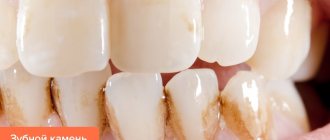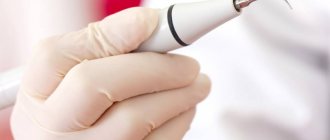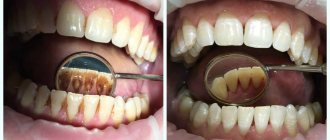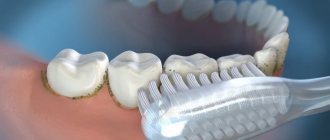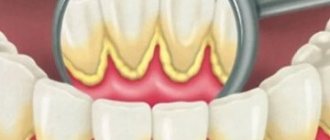Soft plaque that is not removed in time turns into stone over time.
Plaque forms constantly in the oral cavity, since the process of microflora reproduction does not stop (its intensity especially increases after eating). If soft deposits are not removed, they gradually become saturated with mineralized salts contained in saliva and harden (on average, mineralization occurs within 16 hours after eating, but this figure may vary slightly, both smaller and larger).
Why does tartar form?
The appearance of tartar can occur for a number of reasons:
- Poor oral hygiene. First of all, you need to choose the right toothbrush - it should have bristles of different lengths and shapes. It is equally important to use a toothpaste that can effectively cope with plaque – it must have an abrasiveness index of at least 50 RDA.
- Unbalanced diet. Foods high in carbohydrates – flour, pasta, carbonated sweet water, etc. – provoke stone formation.
- Drinking strong black tea and smoking regularly. The latter is especially dangerous, since heated smoke intensifies the inflammatory process in the gums.
- Violation of pH levels. When it decreases, the acidity of saliva increases, as a result of which more minerals and salts are deposited on the surface of the teeth. If the level, on the contrary, increases, the acidity of saliva decreases, which affects the enamel, which becomes more loose.
- High content of fluoride and calcium in saliva. The ions of these components accelerate the formation of tartar.
- Uneven bite. The distance between crowns is a good place for plaque to accumulate.
- Orthopedic fixed structures in the mouth (plaque accumulates in the gaps between dentures and stones form).
- Thyroid diseases and diabetes. These diseases are accompanied by disruption of endocrine processes, which leads to changes in the acidity of saliva.
- The absence of several teeth, which affects chewing. If a person has no teeth on one side, he spontaneously begins to chew on the other side of his mouth. As a result, teeth do not undergo the natural self-cleaning procedure, so plaque accumulates on them.
- Too increased or, conversely, decreased production of saliva due to disturbances in the functioning of the salivary glands.
- The use of medications that affect the composition of saliva.
Is ultrasonic teeth cleaning harmful?
Ultrasonic cleaning does not pose any threat to teeth and the body as a whole. An exception is situations in which the technology is broken or the patient has contraindications. Ultrasound can damage enamel if it is thinned or has such a structural feature. Sometimes brushing causes bleeding from the gums. The doctor will help stop it and advise what needs to be done for speedy healing.
Advice: to avoid possible troubles, before starting the procedure, the dentist finds out the state of health, concomitant diseases, and reaction to medications. Answer honestly and directly, every nuance matters.
Types of tartar
Tartar consists of one third of organic substances (epithelial cells, microorganisms, proteins, etc.) and 2/3 of inorganic substances (mainly calcium salts).
Stones are divided into:
- supragingival, which, as you can guess from their designation, are located above the gum. They are easy to see with the naked eye and are dark yellow in color. Removing such deposits is quite simple.
- subgingival. During a routine examination, they cannot be noticed, but their presence can be assumed by the bluish tint of the gums and increased bleeding in this place. It is possible that pus may be released from the periodontal pocket.
The presence of subgingival stones is the first sign of periodontitis and the beginning of tissue destruction around the tooth. Only a dentist can detect stones located under the gum by probing the pockets. Removing subgingival stones takes a lot of time, so not every doctor will undertake such work.
Types of Dental Raiders
They are divided only by location, so the following types are distinguished:
- Subgingival. They can be localized deep in the gums and are often found on the neck. This type of plaque is very difficult to notice. The risk group for this type of plaque includes people over forty. If you start treating subgingival plaque, you can be left without teeth, in the literal sense of the word.
- Supragingival. As the name suggests, this plaque is localized above the gum on the inner surface of the tooth, so it is very easy to notice. Most often white or yellow.
Supragingival calculus
- A stone bridge. This is when plaque is localized on several teeth in a row.
What does tartar look like?
Tartar: causes of appearance
Leftover food in the mouth after eating is a favorite treat for bacteria. Such microorganisms especially love the so-called “fast” carbohydrates, found in large quantities in flour products and sugar. It has been proven that even if oral hygiene is neglected one day, this will lead to accelerated plaque formation, increasing in volume several times over this period of time.
Bacteria need nutrients both to maintain vital processes and to produce enzymes that allow them to securely attach to the tooth surface. If you brush your teeth poorly, individual bacteria will begin to form colonies, which, in turn, can also merge with each other. Nevertheless, at this stage, eliminating plaque is not yet particularly difficult - you can get rid of it by working well with a toothbrush.
Over time, the plaque will mineralize (calcium salts and proteins present in saliva will begin to settle on the surface of the bacteria, which will proceed in parallel with the formation of new colonies), hardening and increasing in volume.
At the same time, toxins will be released from the plaque, causing the development of the inflammatory process. You can understand that inflammation has begun by pain in the gums, their bleeding during brushing, the flow of pus and increased tooth mobility.
The inflammatory process is of great importance for bacteria: the groove between the gum and tooth constantly receives liquid rich in proteins necessary for bacteria to grow; inflammation increases the formation of this fluid, accordingly, microorganisms receive more proteins, and the growth rate of their colonies becomes higher.
Concluding all of the above, the appearance of a stone is a direct consequence of non-compliance with hygiene.
Postoperative actions
After any type of cleaning, you need to rinse your mouth with some of the products listed below.
- Causes of tartar formation
| Medicinal substance | Breeding method and benefits |
| Sage | It has antimicrobial and anti-inflammatory effects. Dilute one teaspoon per glass of boiled water, close and leave for half an hour. Then strain and rinse four times a day. |
| Chamomile | This plant has a good antiseptic effect. Can also be used for many other diseases. Dilute one tablespoon per glass of boiling water. Close and after twenty minutes strain and rinse. Rinse three times a day. |
| Tincture of calendula | Like all the herbs given above, it is a natural antiseptic. Dilute one teaspoon per glass of boiled water. Close and strain after half an hour. Rinse also three times a day. |
How to remove tartar
If the plaque has formed into stone, then it will no longer be possible to get rid of it with an ordinary brush.
Tartar cleaning in Krasnodar is the only effective way to eliminate deposits. The professional method involves the use of ultrasonic cleaning: removing tartar from all teeth takes about one hour, if we are talking about supragingival deposits. To eliminate subgingival stone, you will have to visit the doctor several times, if his qualifications are sufficient to carry out the procedure.
It is better to immediately contact a periodontist rather than a therapist. This is especially true for people suffering from periodontitis, since they may have stones in the resulting pockets. If it is necessary to clean tartar located above the gum level, then a dentist-therapist will also help.
The cost of tartar removal in our clinic is 3,500 rubles. This includes polishing the teeth with a brush and toothpaste. Polishing teeth using a PROPHY flex device (a mixture of water, compressed air and fine sodium bicarbonate powder - baking soda).
Pastes for removing plaque and polishing teeth –
To remove small tartar and pigmented plaque, we can use 2 groups of products. Firstly, there are some whitening toothpastes that are highly abrasive. The second option is that you can purchase a special paste for polishing teeth in a specialized store that sells consumables for dental clinics (this option is much more effective, and you can even place an order online).
The advantage of the first option is the high availability of whitening toothpastes (list below), but their capabilities will be much more modest when compared with professional polishing paste for removing plaque and plaque. Below we will talk in more detail about each option.
Detartrine Z polishing paste –
Professional polishing pastes “Detartrin” and “Detartrin Z” do an excellent job not only of smoker’s pigment plaque, but also even of small dental deposits. The second version of this paste is especially effective, containing specially sharpened zirconium granules that can remove dental plaque and smoker’s plaque without damaging the enamel (24stoma.ru). In addition, the paste contains essential oils, leaving a long-lasting feeling of freshness in the mouth. Production – (France).
Pastes “Detartrine” and “Detartrine Z” –
The paste is taken from the tube only with a clean spatula and applied to the bristles of the working head of the Oral-b brush. Next, you need to “spread” the paste over several teeth, then turn the brush on at low speed, and treat each tooth for 10-20 seconds (more precisely, as needed). After treating your teeth, you need to rinse your mouth thoroughly several times. Use no more than once a week. The cost of a 45 mg tube of “Detartrine Z” in different stores can range from 1,600 to 2,800 rubles.
There is also another version of this paste - the usual “Detartrine” without zircon. It is a little cheaper, but also copes somewhat worse with, for example, the smoker’s residue. But in any case, both versions of this paste are much more effective at removing pigmented plaque and dental plaque than most other similar products (i.e. similar polishing pastes from other manufacturers).
Toothpaste “PRESIDENT PROFI PLUS White Plus” –
controlled abrasiveness – RDA 200 ,- abrasive and polishing components (silicon dioxide, calcium carbonate, diatomaceous earth, titanium dioxide),
- applied only once a week,
- price 30 ml - about 260 rubles.
It is necessary to apply a small amount of paste to a group of several teeth, and then use the Oral-b toothbrush at low speed, for example, in the “Whitening / Polishing” or “For Sensitive Teeth” modes. The effectiveness of PRESIDENT White Plus will be lower than Detartrine Z.
Toothpaste “LACALUT White” –
controlled abrasiveness – RDA 120 ,- abrasive and polishing components (hydrated silicon dioxide and titanium dioxide),
- benefits – contains pyrophosphates and sodium fluoride,
- fluoride content: 1357 ppm,
- together with an electric brush can be used once every 2 days,
- price: 50 ml – from 250 rub., 75 ml – 350 rub.
The effectiveness of this paste will be significantly lower than the previous ones. And she can only help you with a small amount of not too pronounced pigmentation. Apply according to the same principle as previous products (together with an Oral-B electric brush).
A few additional recommendations -
The cost of a good Oral-B electric brush starts from 2700-3500 rubles (at this link you can read our review on the optimal choice of models). You can even buy “Detartrine Z” or “Detartrine” polishing paste in traditional online stores, but it will be cheaper to do it in those organizations that sell consumables for dental clinics. There are many such companies in every city. And I would like to say a few more words about the selection of toothpaste for daily use in the morning and evening.
It is advisable that in patients with a high rate of tartar formation, such a paste contains polydon or pyrophosphates (these components significantly reduce the rate of mineralization of soft microbial plaque and its transformation into hard tartar). Polyphosphates (for example, sodium hexametaphosphate and trisodium phosphate) can significantly reduce the adhesion and deposition of microbial plaque.
Another useful components are the proteolytic enzymes bromelain and papain. They help loosen the already formed tightly attached microbial plaque, which certainly contributes to its removal by the abrasive components of toothpastes. In addition, it is desirable to contain sodium fluoride or amino fluoride in the paste, and in a concentration of at least 1400 ppm. The fact is that fluoride has a bactericidal effect, suppressing the vital activity of microorganisms, thereby preventing an increase in the volume of microbial plaque in the oral cavity.
Well, in the next section we gave several examples of techniques that are recommended for removing tartar at home - on various thematic sites and forums. You might be interested in reading this nonsense.
Tartar: how to get rid of it at home
Most people understand that the best way to resolve any dental problems is to visit the dentist. However, not everyone likes to contact a specialist, delaying the visit until the last minute in the hope that the problem will somehow resolve itself. This is largely facilitated by advertising offering treatment for all occasions.
So how to remove tartar at home? Unfortunately, no way. Even the most expensive products will not be able to remove thick plaque and stone. However, ultrasonic or electric brushes, as well as special toothpastes, will help get rid of the soft plaque that is just beginning to form.
An electric toothbrush -
Oral-B toothbrushes have a round rotating head with bristles, which in standard mode makes 8,800 rotational and 20,000 pulsating movements per minute. Pulsating movements loosen plaque, and rotational movements sweep it away from the teeth and polish them. It must be said that such brushes are 2 times better at removing plaque (compared to ordinary manual toothbrushes), but usually even they can no longer cope with tightly attached plaque. Therefore, we will use such a brush with a special paste.
For our purposes, it is better to choose a toothbrush model that, in addition to the traditional “Daily Cleaning” mode, will have a “Whitening/Polishing” or “For Sensitive Teeth” mode. This is necessary so that the brush operates at lower speeds, because in this case, “faster does not mean better.” And keep in mind that electric brushes with a different operating principle (for example, sonic or ultrasonic) are not suitable for our purposes.
My electric toothbrushes -
The first photo shows my first toothbrush, “Oral-B PRO 500 CrossAction” (it’s a great brush, but I don’t use it anymore). This is an excellent brush for hygiene, but there is only 1 operating mode, “Daily Cleaning,” in which the nozzle makes 8,800 reciprocating and 20,000 pulsating movements per minute. This mode is not very suitable for polishing teeth with special pastes, because... the paste will splash heavily at high speed, and besides, such pastes remove dental plaque better at low speeds.
The second photo shows the Oral-B Genius 9000 toothbrush, which I have been using for the last 3 years. This model has many modes, including the “Whitening/polishing” mode we need. Another important detail - for our purposes, the most suitable type of attachments is “Precision Clean” (see photo below), which almost exactly resembles polishing brushes in a dentist’s office. Well, in the next section we will move on to discussing polishing agents.
Consequences of stones
If the stones are not removed, this can lead to:
- the appearance of bad breath (its cause is the vital activity of microorganisms that have settled on the surface of the teeth);
- the formation of caries (bacteria in the process of life produce hydrochloric acid, which corrodes the enamel, which contributes to the onset of decay);
- inflammation of the gums, their bleeding, which can subsequently result in periodontitis;
- diseases of the mucous membrane (accumulation of colonies of microbes on the teeth can lead to ulcers and erosions);
- worsening of existing diseases (diabetes, heart disease, etc.).
Complications of unremoved dental “fossils”
If you do not visit the dentist regularly, you may experience complications such as:
- inflammation of the gums;
- bleeding gums;
- caries. Plaque contains microorganisms that lead to caries;
- stains on enamel. Most often they are localized at the point of transition from the gum to the root;
- gum atrophy.
The presence of such stones indicates the development of periodontitis, and is associated with the destruction of the attachment of the gum to the tooth, as well as the destruction of bone tissue around the tooth
How to remove tartar
There are the following methods for removing tartar:
- manual;
- using ultrasound;
- using laser;
- sandblasting;
- chemical method.
Each of these methods has its pros and cons.
The mechanical or manual method is the oldest method of removing tartar in Krasnodar, so it is used extremely rarely. Cleaning is carried out either manually (the doctor uses special tools to remove stones) or using a drill with special attachments. Its advantages include low cost and versatility, but its disadvantages are that it is traumatic for the gums and a long recovery period.
Ultrasound is a more modern and effective method. Special devices called scalers are used for it: they can emit ultrasonic vibrations with a frequency of up to 50 kHz. The impact of scalers can be mechanical (vibrations are transmitted to the attachments that act on the teeth) or by the cavitation method (during operation, an antiseptic solution is supplied, in which bubbles are formed under the influence of ultrasonic waves, exploding at the moment of contact with the surface of the teeth, which leads to the destruction of stones) . Unlike the previous method, scalers do not injure teeth and gums, and their use is completely painless for the patient. However, there are contraindications: for example, the presence of braces prohibits the use of the method.
Cleaning tartar using sandblasting involves removing deposits with a mixture of water, air and abrasive. The method is characterized by the absence of trauma, after its use the teeth can become several shades lighter, and the presence of braces is not an obstacle. However, sandblasting cannot get rid of large deposits, and during the procedure, the taste of soda is clearly felt in the mouth, which can be unpleasant for the patient.
Laser cleaning is an innovative method that is less traumatic. The teeth are treated with a laser beam, which evaporates the liquid from the deposits, resulting in their destruction. There is no damage to the enamel. The method is quite expensive: perhaps that is why it is not very widespread. In addition, there are many contraindications for its use.
A chemical method is used to soften particularly large deposits. A special product is applied to the stone, which makes it loose, after which the deposit is removed using any of the above methods. In order not to damage the gums, before the start of the event they are treated with a rubber dam - a product that protects against burns. Among the advantages, it is worth highlighting the possibility of removing old deposits and safety for fillings. The disadvantages are the impossibility of using it as the only method, the impossibility of removing subgingival deposits with its help, and the prohibition of use for gingivitis.
It is worth understanding that it will not be possible to get rid of tartar at home: even the most modern and expensive toothpaste from tartar can only remove soft plaque that has a loose structure, but if the hardening process of the deposits has already completed, you can only get rid of them in the hospital.
Ultrasound removal of dental plaque: features, stages and prices
Ultrasound removal of dental plaque is a modern and highly effective method of oral hygiene. Ultrasound will help:
- Carry out the removal of supragingival and subgingival tartar;
- Quickly remove pigmented plaque;
- Eliminate soft microbial plaque.
Removing dental plaque is a procedure that is carried out in three stages. Below we will tell you in detail how the process of removing dental plaque with ultrasound will take place in the dentist’s office.
STEP 1: Ultrasound removal of plaque and tartar
Ultrasound removal of dental plaque is carried out using special equipment - ultrasonic scalers.
Scalers can be either a separate device or part of a dental unit. The main working element of the scaler is its tip with a metal attachment. The tip of this metal nozzle vibrates at high frequencies in the ultrasonic range. Also, water is supplied through the nozzle, which washes away decayed dental plaque from the patient’s mouth and is immediately removed with a saliva ejector.
Preventive measures
The best method of prevention is careful hygiene. Basic rules that should be followed to prevent the formation of stones and other problems with teeth are as follows:
- Teeth must be brushed after every meal;
- Before using the paste, you should use dental floss, since the brush cannot penetrate into all the spaces between the teeth;
- If you can't floss outside the home, you can chew chewing gum.
Free consultation on the cost of treatment in our dentistry
Leave a request and the clinic administrator will contact you within 15 minutes!
The scaler effectively removes dental plaque because:
1. Its nozzle creates oscillatory movements that destroy plaque and tartar. In order for the removal of dental plaque to be carried out efficiently and without damaging the teeth, it is extremely important that the vibrations of the nozzle are directed along the dental surfaces.
2. During the operation of the scaler, water is supplied to the oral cavity, which is needed not only to wash out destroyed deposits and cool the nozzle. Ultrasound in an aqueous environment creates many small bubbles, which immediately burst, releasing a large amount of energy. This energy promotes improved removal of dental plaque from tooth enamel, and in addition, helps eliminate pathogenic microflora in the oral cavity.
After removing plaque, the second stage of ultrasonic cleaning is carried out - teeth polishing.
STEP 2: Polishing teeth after removing dental plaque with ultrasound
Polishing teeth after removing dental plaque is an event that must be carried out without fail.
After removing deposits with ultrasound, microscopic particles of plaque and stone may remain on the dental surfaces, making the tooth enamel uneven and rough, which will provide optimal conditions for the accelerated accumulation of a new layer of plaque. Polishing teeth after removing deposits can be done with hand tools, but most often the Air Flow technology is used for polishing, which we briefly told you about above. When manually polishing teeth, after removing plaque, pastes, brushes and strips are used - thin strips with an abrasive layer, which polish the space between the teeth.
STAGE 3: Remineralization of teeth after removal of plaque and tartar
This stage is not considered mandatory and, moreover, many clinics do not include it in the procedure for professional removal of dental plaque.
However, remineralization must be carried out after removing plaque and tartar from the teeth. It helps strengthen tooth enamel and relieve sensitivity that may occur in the neck area of teeth after plaque removal. Remineralization of teeth is carried out immediately after removing plaque and tartar and uses special preparations based on sodium fluoride.
Contraindications
The most important contraindication is the presence of a pacemaker in the patient. Ultrasonic waves can disrupt its operation.
Other restrictions also apply to health conditions:
- asthma, bronchospasm, tuberculosis,
- increased risk of bleeding,
- allergies to the drugs used,
- infectious and viral diseases,
- oncology,
- mental illness, epilepsy.
Attention: Relative contraindications are pregnancy (first trimester), childhood (up to 16-18 years). The decision to perform the procedure is made by the dentist.
